Consolidated Portfolio: Project Management Practices and Outcomes
VerifiedAdded on 2023/06/11
|11
|2762
|294
Portfolio
AI Summary
This consolidated portfolio summarizes key learnings from weekly assignments related to project management. It covers the advantages and disadvantages of manual and electronic project management application systems across different knowledge areas, the appropriate application of project management systems for successful project execution, and the identification of project management applications that assist in monitoring performance and managing changes. The portfolio highlights the transition from manual to automated data management systems, emphasizing the benefits of automation in terms of efficiency, accuracy, and resource integration. It also discusses the importance of project management methodologies like Agile, PRINCE2, and PMBOK in reducing project complexity and ensuring strategic organizational success. The discussion concludes that effective project management practices provide a competitive advantage and require consideration of time, scope, quality, and stakeholder management.
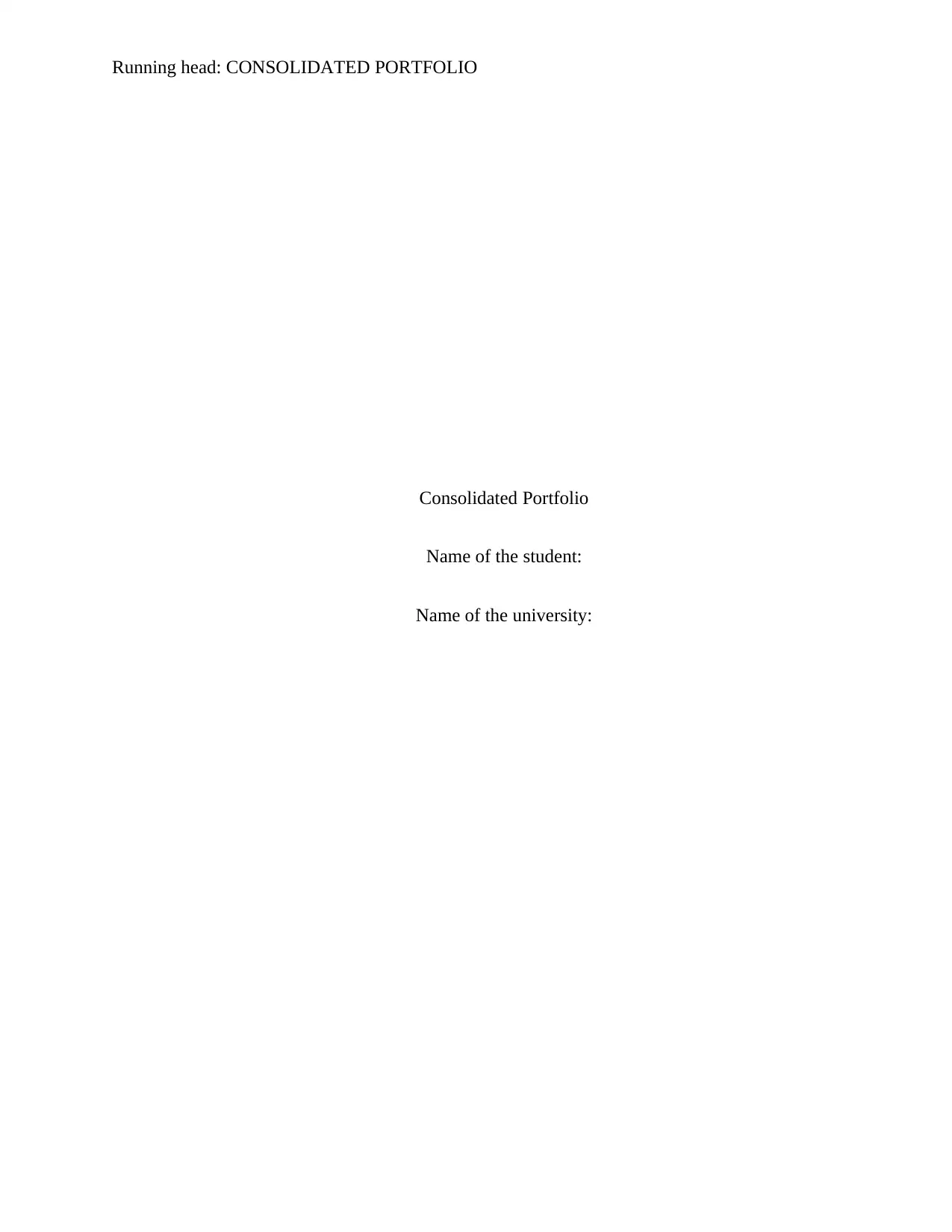
Running head: CONSOLIDATED PORTFOLIO
Consolidated Portfolio
Name of the student:
Name of the university:
Consolidated Portfolio
Name of the student:
Name of the university:
Paraphrase This Document
Need a fresh take? Get an instant paraphrase of this document with our AI Paraphraser
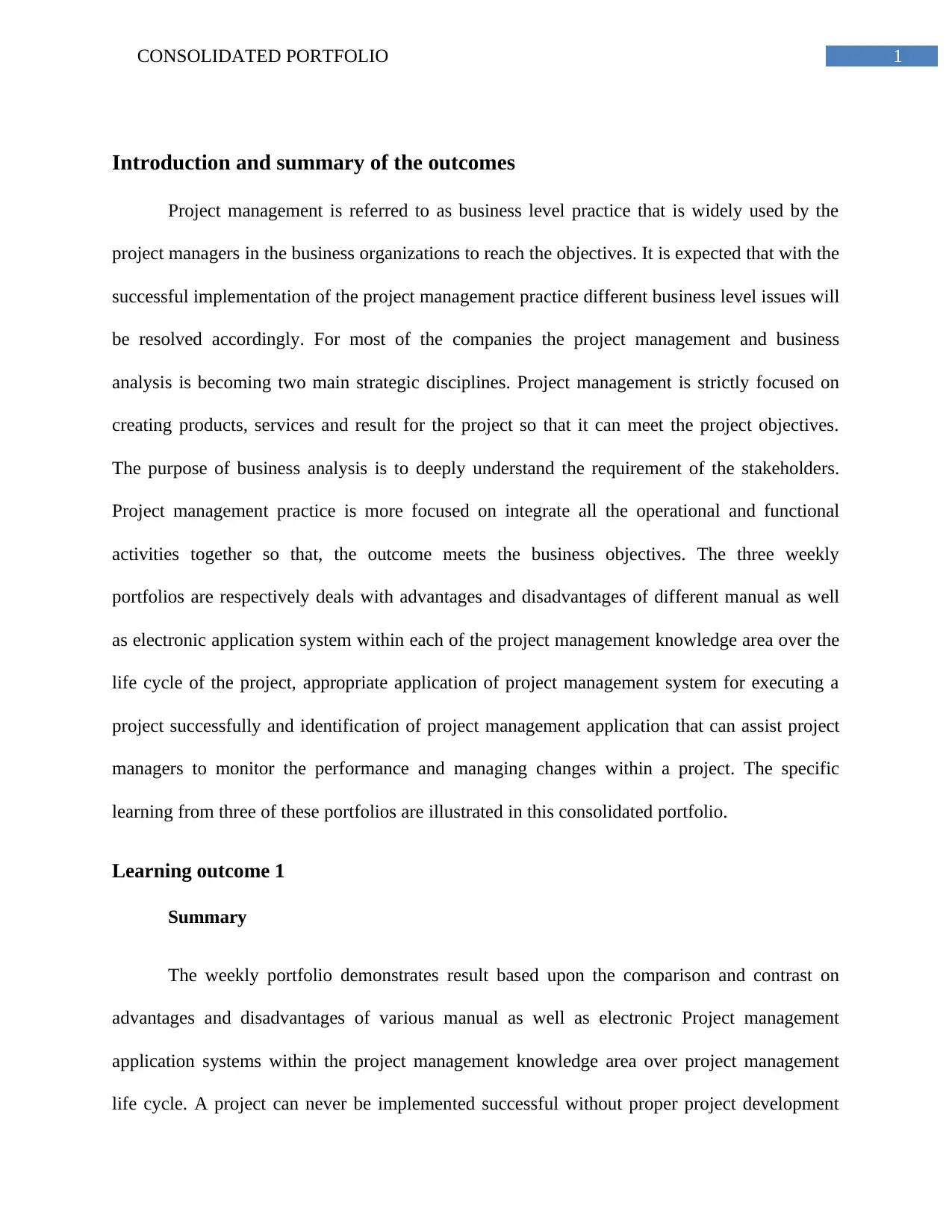
1CONSOLIDATED PORTFOLIO
Introduction and summary of the outcomes
Project management is referred to as business level practice that is widely used by the
project managers in the business organizations to reach the objectives. It is expected that with the
successful implementation of the project management practice different business level issues will
be resolved accordingly. For most of the companies the project management and business
analysis is becoming two main strategic disciplines. Project management is strictly focused on
creating products, services and result for the project so that it can meet the project objectives.
The purpose of business analysis is to deeply understand the requirement of the stakeholders.
Project management practice is more focused on integrate all the operational and functional
activities together so that, the outcome meets the business objectives. The three weekly
portfolios are respectively deals with advantages and disadvantages of different manual as well
as electronic application system within each of the project management knowledge area over the
life cycle of the project, appropriate application of project management system for executing a
project successfully and identification of project management application that can assist project
managers to monitor the performance and managing changes within a project. The specific
learning from three of these portfolios are illustrated in this consolidated portfolio.
Learning outcome 1
Summary
The weekly portfolio demonstrates result based upon the comparison and contrast on
advantages and disadvantages of various manual as well as electronic Project management
application systems within the project management knowledge area over project management
life cycle. A project can never be implemented successful without proper project development
Introduction and summary of the outcomes
Project management is referred to as business level practice that is widely used by the
project managers in the business organizations to reach the objectives. It is expected that with the
successful implementation of the project management practice different business level issues will
be resolved accordingly. For most of the companies the project management and business
analysis is becoming two main strategic disciplines. Project management is strictly focused on
creating products, services and result for the project so that it can meet the project objectives.
The purpose of business analysis is to deeply understand the requirement of the stakeholders.
Project management practice is more focused on integrate all the operational and functional
activities together so that, the outcome meets the business objectives. The three weekly
portfolios are respectively deals with advantages and disadvantages of different manual as well
as electronic application system within each of the project management knowledge area over the
life cycle of the project, appropriate application of project management system for executing a
project successfully and identification of project management application that can assist project
managers to monitor the performance and managing changes within a project. The specific
learning from three of these portfolios are illustrated in this consolidated portfolio.
Learning outcome 1
Summary
The weekly portfolio demonstrates result based upon the comparison and contrast on
advantages and disadvantages of various manual as well as electronic Project management
application systems within the project management knowledge area over project management
life cycle. A project can never be implemented successful without proper project development
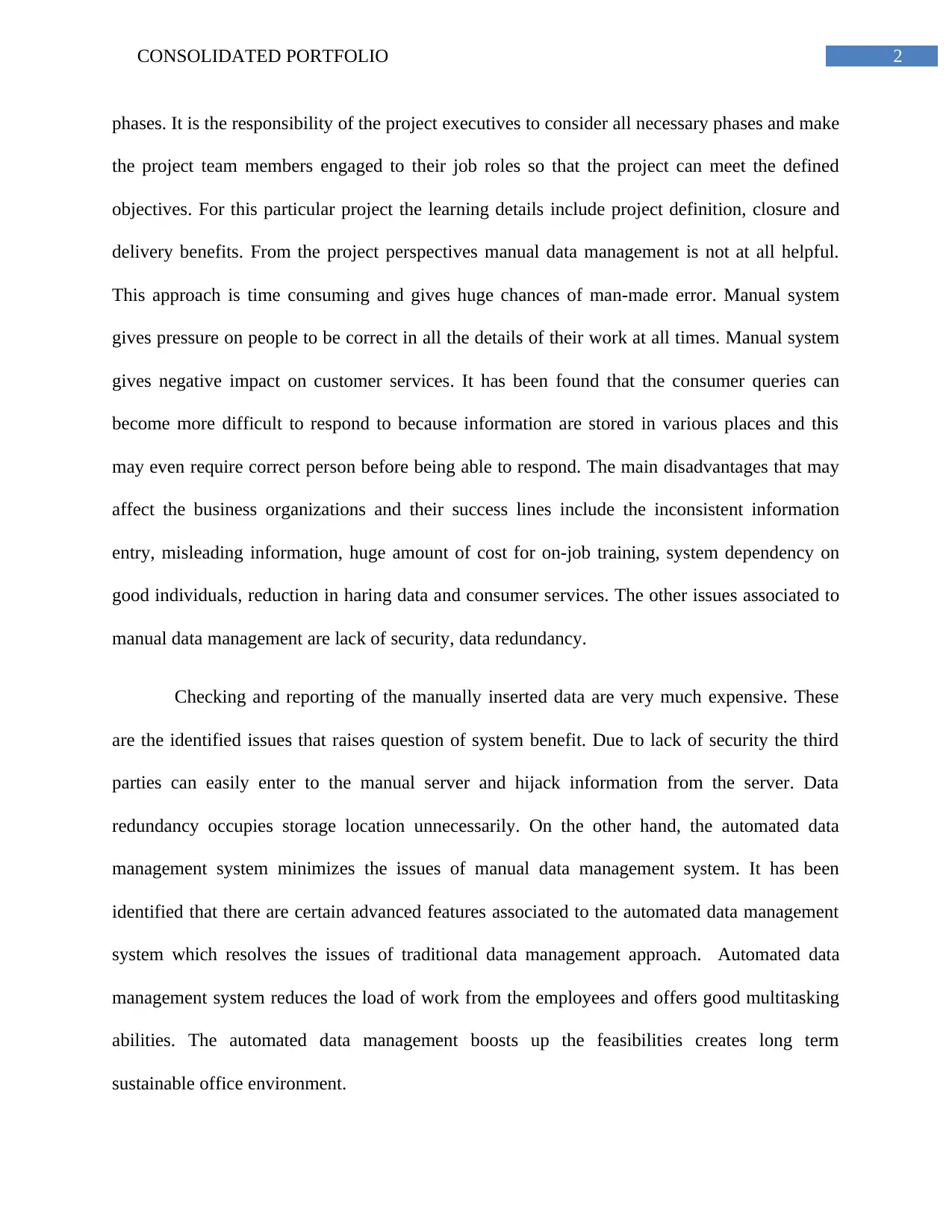
2CONSOLIDATED PORTFOLIO
phases. It is the responsibility of the project executives to consider all necessary phases and make
the project team members engaged to their job roles so that the project can meet the defined
objectives. For this particular project the learning details include project definition, closure and
delivery benefits. From the project perspectives manual data management is not at all helpful.
This approach is time consuming and gives huge chances of man-made error. Manual system
gives pressure on people to be correct in all the details of their work at all times. Manual system
gives negative impact on customer services. It has been found that the consumer queries can
become more difficult to respond to because information are stored in various places and this
may even require correct person before being able to respond. The main disadvantages that may
affect the business organizations and their success lines include the inconsistent information
entry, misleading information, huge amount of cost for on-job training, system dependency on
good individuals, reduction in haring data and consumer services. The other issues associated to
manual data management are lack of security, data redundancy.
Checking and reporting of the manually inserted data are very much expensive. These
are the identified issues that raises question of system benefit. Due to lack of security the third
parties can easily enter to the manual server and hijack information from the server. Data
redundancy occupies storage location unnecessarily. On the other hand, the automated data
management system minimizes the issues of manual data management system. It has been
identified that there are certain advanced features associated to the automated data management
system which resolves the issues of traditional data management approach. Automated data
management system reduces the load of work from the employees and offers good multitasking
abilities. The automated data management boosts up the feasibilities creates long term
sustainable office environment.
phases. It is the responsibility of the project executives to consider all necessary phases and make
the project team members engaged to their job roles so that the project can meet the defined
objectives. For this particular project the learning details include project definition, closure and
delivery benefits. From the project perspectives manual data management is not at all helpful.
This approach is time consuming and gives huge chances of man-made error. Manual system
gives pressure on people to be correct in all the details of their work at all times. Manual system
gives negative impact on customer services. It has been found that the consumer queries can
become more difficult to respond to because information are stored in various places and this
may even require correct person before being able to respond. The main disadvantages that may
affect the business organizations and their success lines include the inconsistent information
entry, misleading information, huge amount of cost for on-job training, system dependency on
good individuals, reduction in haring data and consumer services. The other issues associated to
manual data management are lack of security, data redundancy.
Checking and reporting of the manually inserted data are very much expensive. These
are the identified issues that raises question of system benefit. Due to lack of security the third
parties can easily enter to the manual server and hijack information from the server. Data
redundancy occupies storage location unnecessarily. On the other hand, the automated data
management system minimizes the issues of manual data management system. It has been
identified that there are certain advanced features associated to the automated data management
system which resolves the issues of traditional data management approach. Automated data
management system reduces the load of work from the employees and offers good multitasking
abilities. The automated data management boosts up the feasibilities creates long term
sustainable office environment.
⊘ This is a preview!⊘
Do you want full access?
Subscribe today to unlock all pages.

Trusted by 1+ million students worldwide
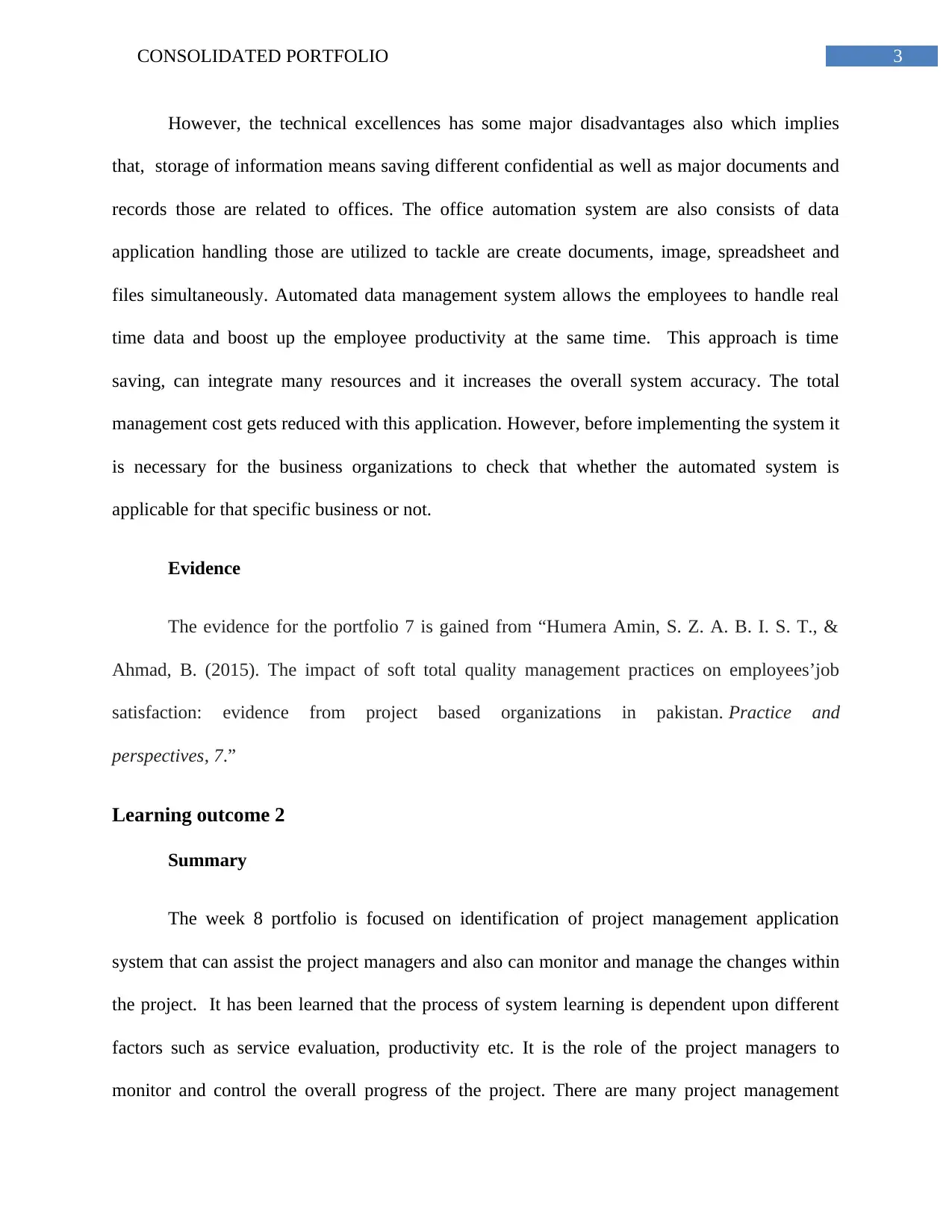
3CONSOLIDATED PORTFOLIO
However, the technical excellences has some major disadvantages also which implies
that, storage of information means saving different confidential as well as major documents and
records those are related to offices. The office automation system are also consists of data
application handling those are utilized to tackle are create documents, image, spreadsheet and
files simultaneously. Automated data management system allows the employees to handle real
time data and boost up the employee productivity at the same time. This approach is time
saving, can integrate many resources and it increases the overall system accuracy. The total
management cost gets reduced with this application. However, before implementing the system it
is necessary for the business organizations to check that whether the automated system is
applicable for that specific business or not.
Evidence
The evidence for the portfolio 7 is gained from “Humera Amin, S. Z. A. B. I. S. T., &
Ahmad, B. (2015). The impact of soft total quality management practices on employees’job
satisfaction: evidence from project based organizations in pakistan. Practice and
perspectives, 7.”
Learning outcome 2
Summary
The week 8 portfolio is focused on identification of project management application
system that can assist the project managers and also can monitor and manage the changes within
the project. It has been learned that the process of system learning is dependent upon different
factors such as service evaluation, productivity etc. It is the role of the project managers to
monitor and control the overall progress of the project. There are many project management
However, the technical excellences has some major disadvantages also which implies
that, storage of information means saving different confidential as well as major documents and
records those are related to offices. The office automation system are also consists of data
application handling those are utilized to tackle are create documents, image, spreadsheet and
files simultaneously. Automated data management system allows the employees to handle real
time data and boost up the employee productivity at the same time. This approach is time
saving, can integrate many resources and it increases the overall system accuracy. The total
management cost gets reduced with this application. However, before implementing the system it
is necessary for the business organizations to check that whether the automated system is
applicable for that specific business or not.
Evidence
The evidence for the portfolio 7 is gained from “Humera Amin, S. Z. A. B. I. S. T., &
Ahmad, B. (2015). The impact of soft total quality management practices on employees’job
satisfaction: evidence from project based organizations in pakistan. Practice and
perspectives, 7.”
Learning outcome 2
Summary
The week 8 portfolio is focused on identification of project management application
system that can assist the project managers and also can monitor and manage the changes within
the project. It has been learned that the process of system learning is dependent upon different
factors such as service evaluation, productivity etc. It is the role of the project managers to
monitor and control the overall progress of the project. There are many project management
Paraphrase This Document
Need a fresh take? Get an instant paraphrase of this document with our AI Paraphraser
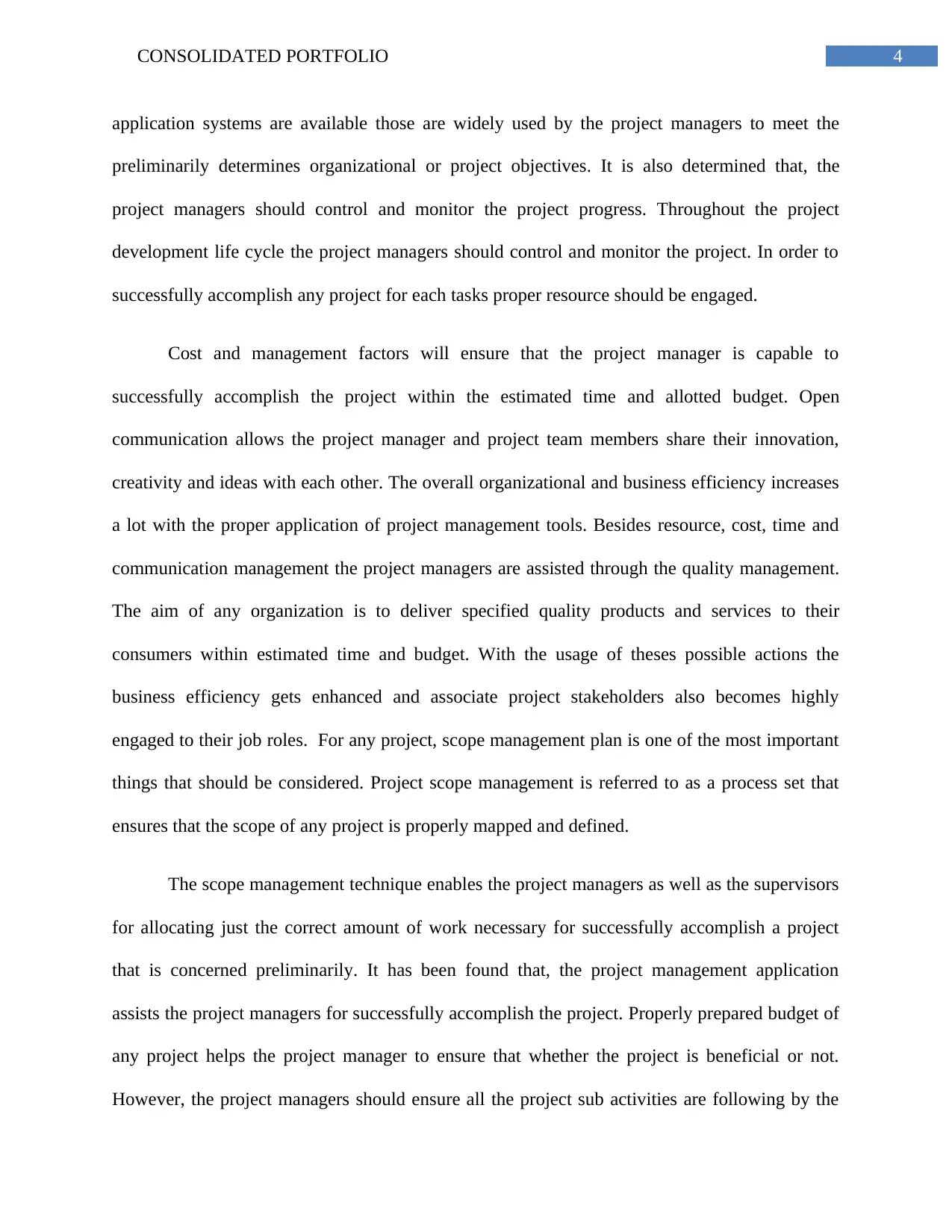
4CONSOLIDATED PORTFOLIO
application systems are available those are widely used by the project managers to meet the
preliminarily determines organizational or project objectives. It is also determined that, the
project managers should control and monitor the project progress. Throughout the project
development life cycle the project managers should control and monitor the project. In order to
successfully accomplish any project for each tasks proper resource should be engaged.
Cost and management factors will ensure that the project manager is capable to
successfully accomplish the project within the estimated time and allotted budget. Open
communication allows the project manager and project team members share their innovation,
creativity and ideas with each other. The overall organizational and business efficiency increases
a lot with the proper application of project management tools. Besides resource, cost, time and
communication management the project managers are assisted through the quality management.
The aim of any organization is to deliver specified quality products and services to their
consumers within estimated time and budget. With the usage of theses possible actions the
business efficiency gets enhanced and associate project stakeholders also becomes highly
engaged to their job roles. For any project, scope management plan is one of the most important
things that should be considered. Project scope management is referred to as a process set that
ensures that the scope of any project is properly mapped and defined.
The scope management technique enables the project managers as well as the supervisors
for allocating just the correct amount of work necessary for successfully accomplish a project
that is concerned preliminarily. It has been found that, the project management application
assists the project managers for successfully accomplish the project. Properly prepared budget of
any project helps the project manager to ensure that whether the project is beneficial or not.
However, the project managers should ensure all the project sub activities are following by the
application systems are available those are widely used by the project managers to meet the
preliminarily determines organizational or project objectives. It is also determined that, the
project managers should control and monitor the project progress. Throughout the project
development life cycle the project managers should control and monitor the project. In order to
successfully accomplish any project for each tasks proper resource should be engaged.
Cost and management factors will ensure that the project manager is capable to
successfully accomplish the project within the estimated time and allotted budget. Open
communication allows the project manager and project team members share their innovation,
creativity and ideas with each other. The overall organizational and business efficiency increases
a lot with the proper application of project management tools. Besides resource, cost, time and
communication management the project managers are assisted through the quality management.
The aim of any organization is to deliver specified quality products and services to their
consumers within estimated time and budget. With the usage of theses possible actions the
business efficiency gets enhanced and associate project stakeholders also becomes highly
engaged to their job roles. For any project, scope management plan is one of the most important
things that should be considered. Project scope management is referred to as a process set that
ensures that the scope of any project is properly mapped and defined.
The scope management technique enables the project managers as well as the supervisors
for allocating just the correct amount of work necessary for successfully accomplish a project
that is concerned preliminarily. It has been found that, the project management application
assists the project managers for successfully accomplish the project. Properly prepared budget of
any project helps the project manager to ensure that whether the project is beneficial or not.
However, the project managers should ensure all the project sub activities are following by the
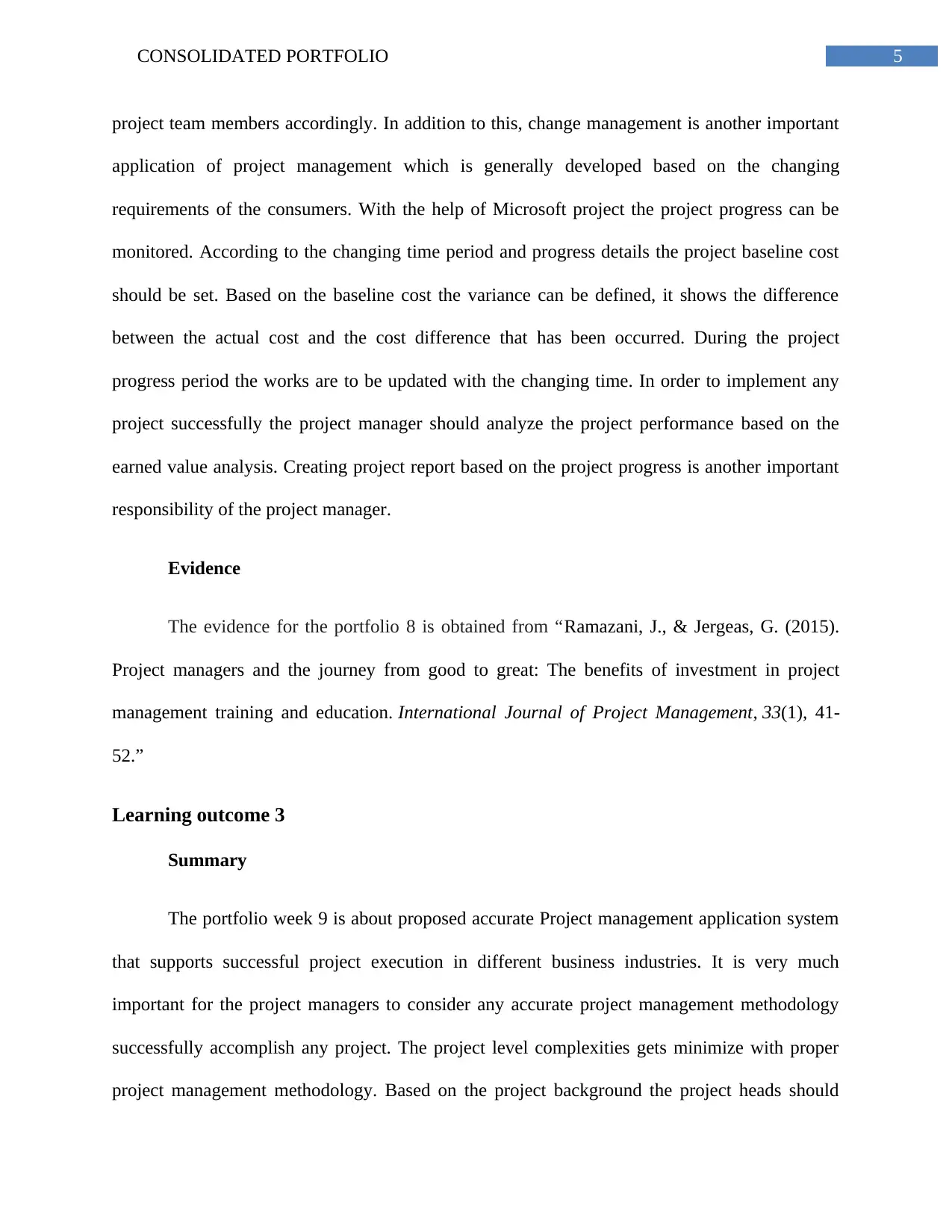
5CONSOLIDATED PORTFOLIO
project team members accordingly. In addition to this, change management is another important
application of project management which is generally developed based on the changing
requirements of the consumers. With the help of Microsoft project the project progress can be
monitored. According to the changing time period and progress details the project baseline cost
should be set. Based on the baseline cost the variance can be defined, it shows the difference
between the actual cost and the cost difference that has been occurred. During the project
progress period the works are to be updated with the changing time. In order to implement any
project successfully the project manager should analyze the project performance based on the
earned value analysis. Creating project report based on the project progress is another important
responsibility of the project manager.
Evidence
The evidence for the portfolio 8 is obtained from “Ramazani, J., & Jergeas, G. (2015).
Project managers and the journey from good to great: The benefits of investment in project
management training and education. International Journal of Project Management, 33(1), 41-
52.”
Learning outcome 3
Summary
The portfolio week 9 is about proposed accurate Project management application system
that supports successful project execution in different business industries. It is very much
important for the project managers to consider any accurate project management methodology
successfully accomplish any project. The project level complexities gets minimize with proper
project management methodology. Based on the project background the project heads should
project team members accordingly. In addition to this, change management is another important
application of project management which is generally developed based on the changing
requirements of the consumers. With the help of Microsoft project the project progress can be
monitored. According to the changing time period and progress details the project baseline cost
should be set. Based on the baseline cost the variance can be defined, it shows the difference
between the actual cost and the cost difference that has been occurred. During the project
progress period the works are to be updated with the changing time. In order to implement any
project successfully the project manager should analyze the project performance based on the
earned value analysis. Creating project report based on the project progress is another important
responsibility of the project manager.
Evidence
The evidence for the portfolio 8 is obtained from “Ramazani, J., & Jergeas, G. (2015).
Project managers and the journey from good to great: The benefits of investment in project
management training and education. International Journal of Project Management, 33(1), 41-
52.”
Learning outcome 3
Summary
The portfolio week 9 is about proposed accurate Project management application system
that supports successful project execution in different business industries. It is very much
important for the project managers to consider any accurate project management methodology
successfully accomplish any project. The project level complexities gets minimize with proper
project management methodology. Based on the project background the project heads should
⊘ This is a preview!⊘
Do you want full access?
Subscribe today to unlock all pages.

Trusted by 1+ million students worldwide
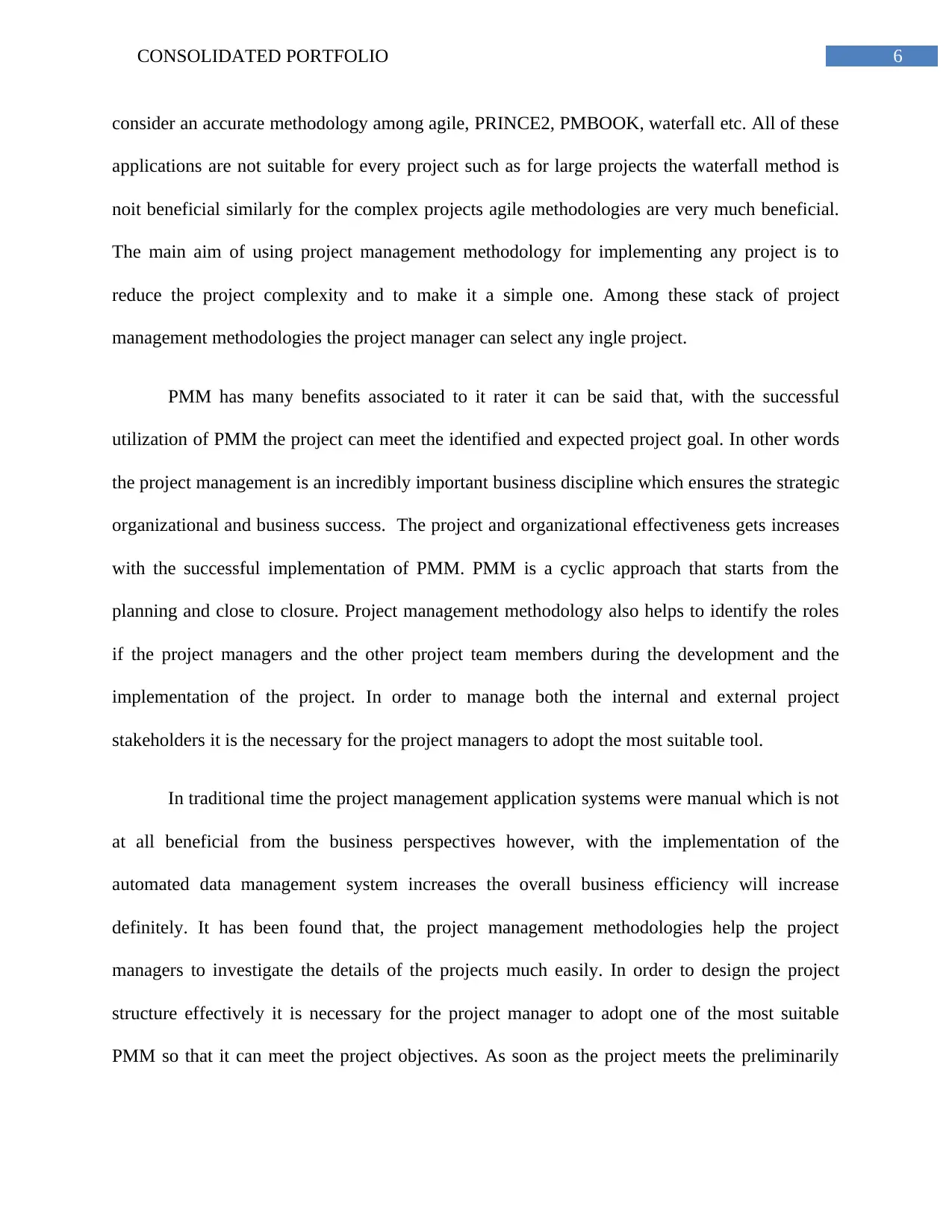
6CONSOLIDATED PORTFOLIO
consider an accurate methodology among agile, PRINCE2, PMBOOK, waterfall etc. All of these
applications are not suitable for every project such as for large projects the waterfall method is
noit beneficial similarly for the complex projects agile methodologies are very much beneficial.
The main aim of using project management methodology for implementing any project is to
reduce the project complexity and to make it a simple one. Among these stack of project
management methodologies the project manager can select any ingle project.
PMM has many benefits associated to it rater it can be said that, with the successful
utilization of PMM the project can meet the identified and expected project goal. In other words
the project management is an incredibly important business discipline which ensures the strategic
organizational and business success. The project and organizational effectiveness gets increases
with the successful implementation of PMM. PMM is a cyclic approach that starts from the
planning and close to closure. Project management methodology also helps to identify the roles
if the project managers and the other project team members during the development and the
implementation of the project. In order to manage both the internal and external project
stakeholders it is the necessary for the project managers to adopt the most suitable tool.
In traditional time the project management application systems were manual which is not
at all beneficial from the business perspectives however, with the implementation of the
automated data management system increases the overall business efficiency will increase
definitely. It has been found that, the project management methodologies help the project
managers to investigate the details of the projects much easily. In order to design the project
structure effectively it is necessary for the project manager to adopt one of the most suitable
PMM so that it can meet the project objectives. As soon as the project meets the preliminarily
consider an accurate methodology among agile, PRINCE2, PMBOOK, waterfall etc. All of these
applications are not suitable for every project such as for large projects the waterfall method is
noit beneficial similarly for the complex projects agile methodologies are very much beneficial.
The main aim of using project management methodology for implementing any project is to
reduce the project complexity and to make it a simple one. Among these stack of project
management methodologies the project manager can select any ingle project.
PMM has many benefits associated to it rater it can be said that, with the successful
utilization of PMM the project can meet the identified and expected project goal. In other words
the project management is an incredibly important business discipline which ensures the strategic
organizational and business success. The project and organizational effectiveness gets increases
with the successful implementation of PMM. PMM is a cyclic approach that starts from the
planning and close to closure. Project management methodology also helps to identify the roles
if the project managers and the other project team members during the development and the
implementation of the project. In order to manage both the internal and external project
stakeholders it is the necessary for the project managers to adopt the most suitable tool.
In traditional time the project management application systems were manual which is not
at all beneficial from the business perspectives however, with the implementation of the
automated data management system increases the overall business efficiency will increase
definitely. It has been found that, the project management methodologies help the project
managers to investigate the details of the projects much easily. In order to design the project
structure effectively it is necessary for the project manager to adopt one of the most suitable
PMM so that it can meet the project objectives. As soon as the project meets the preliminarily
Paraphrase This Document
Need a fresh take? Get an instant paraphrase of this document with our AI Paraphraser
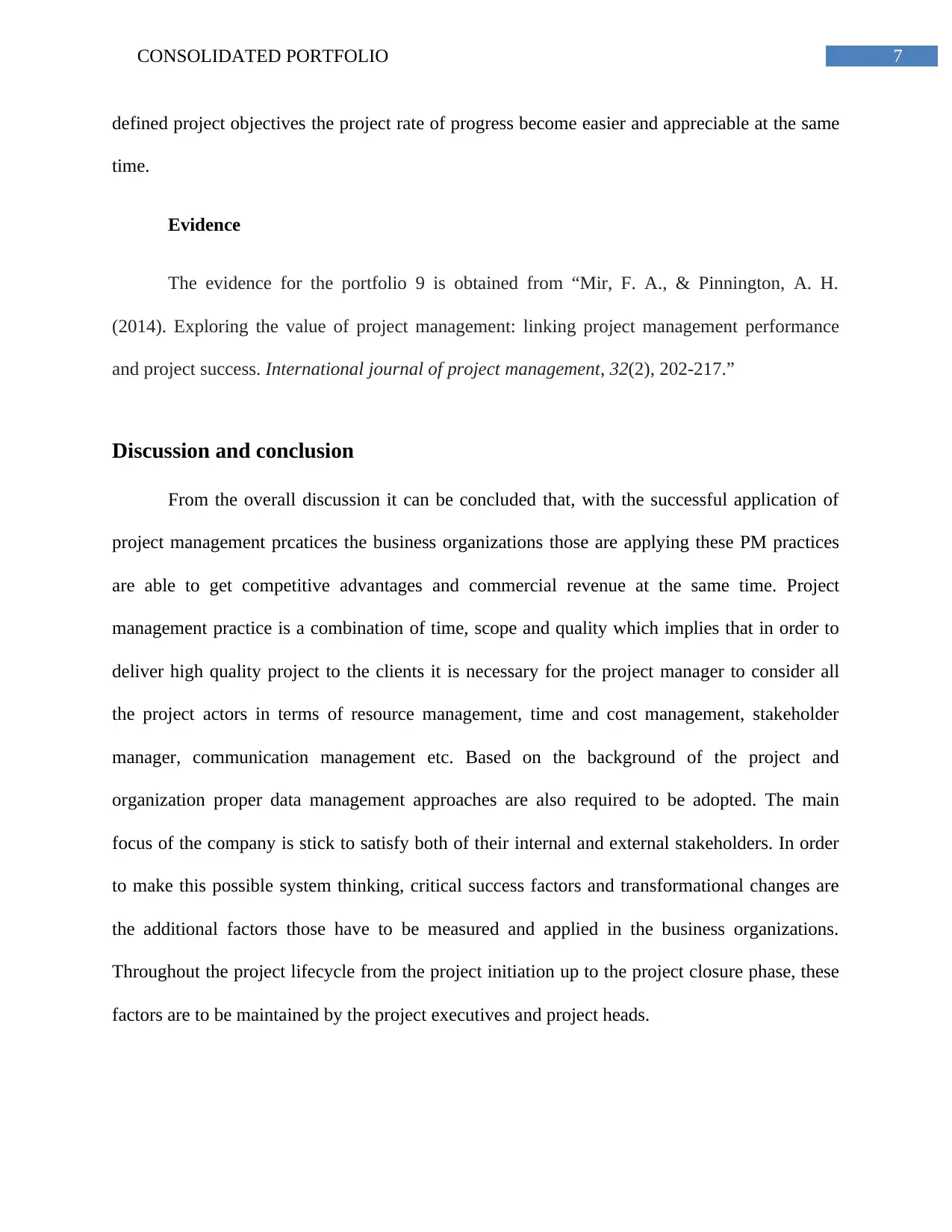
7CONSOLIDATED PORTFOLIO
defined project objectives the project rate of progress become easier and appreciable at the same
time.
Evidence
The evidence for the portfolio 9 is obtained from “Mir, F. A., & Pinnington, A. H.
(2014). Exploring the value of project management: linking project management performance
and project success. International journal of project management, 32(2), 202-217.”
Discussion and conclusion
From the overall discussion it can be concluded that, with the successful application of
project management prcatices the business organizations those are applying these PM practices
are able to get competitive advantages and commercial revenue at the same time. Project
management practice is a combination of time, scope and quality which implies that in order to
deliver high quality project to the clients it is necessary for the project manager to consider all
the project actors in terms of resource management, time and cost management, stakeholder
manager, communication management etc. Based on the background of the project and
organization proper data management approaches are also required to be adopted. The main
focus of the company is stick to satisfy both of their internal and external stakeholders. In order
to make this possible system thinking, critical success factors and transformational changes are
the additional factors those have to be measured and applied in the business organizations.
Throughout the project lifecycle from the project initiation up to the project closure phase, these
factors are to be maintained by the project executives and project heads.
defined project objectives the project rate of progress become easier and appreciable at the same
time.
Evidence
The evidence for the portfolio 9 is obtained from “Mir, F. A., & Pinnington, A. H.
(2014). Exploring the value of project management: linking project management performance
and project success. International journal of project management, 32(2), 202-217.”
Discussion and conclusion
From the overall discussion it can be concluded that, with the successful application of
project management prcatices the business organizations those are applying these PM practices
are able to get competitive advantages and commercial revenue at the same time. Project
management practice is a combination of time, scope and quality which implies that in order to
deliver high quality project to the clients it is necessary for the project manager to consider all
the project actors in terms of resource management, time and cost management, stakeholder
manager, communication management etc. Based on the background of the project and
organization proper data management approaches are also required to be adopted. The main
focus of the company is stick to satisfy both of their internal and external stakeholders. In order
to make this possible system thinking, critical success factors and transformational changes are
the additional factors those have to be measured and applied in the business organizations.
Throughout the project lifecycle from the project initiation up to the project closure phase, these
factors are to be maintained by the project executives and project heads.
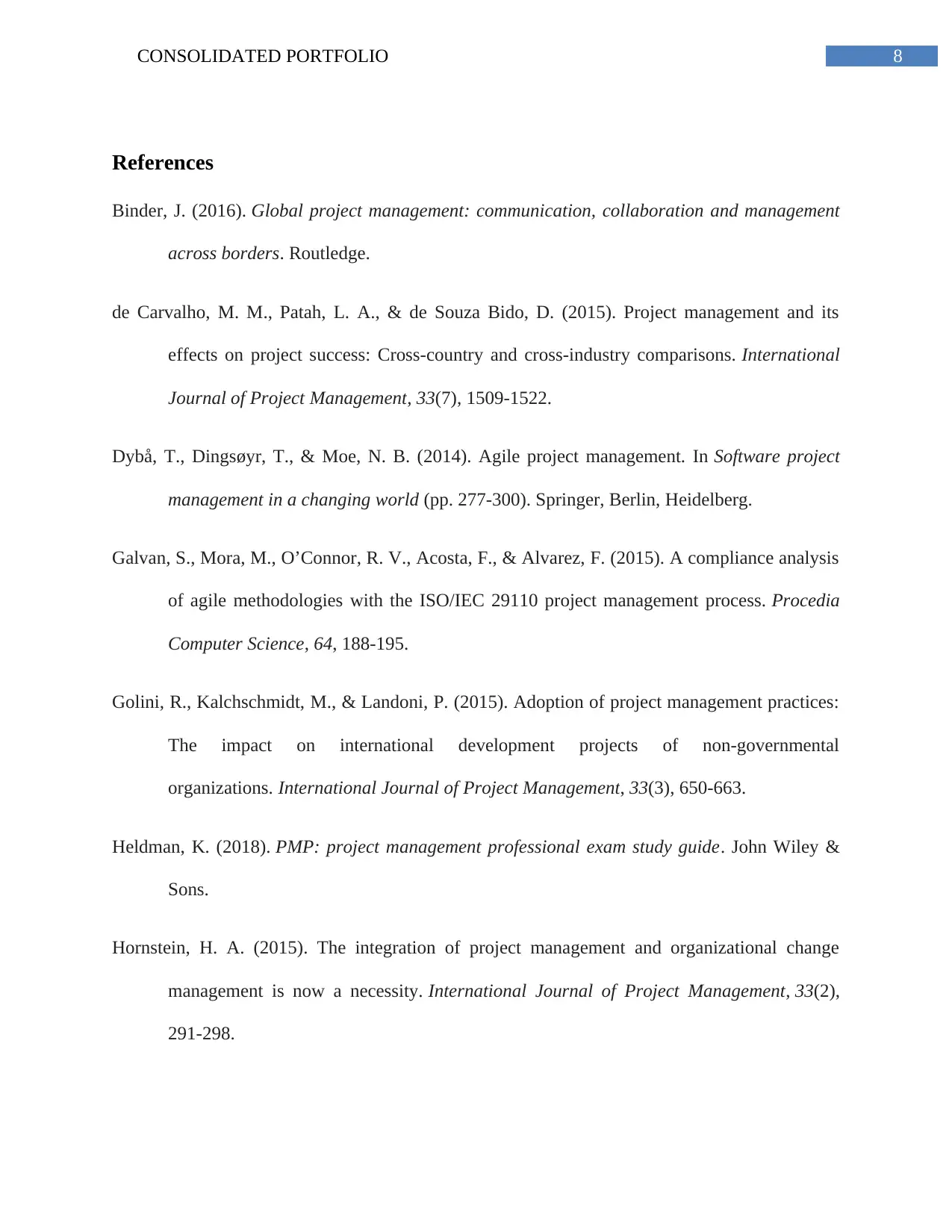
8CONSOLIDATED PORTFOLIO
References
Binder, J. (2016). Global project management: communication, collaboration and management
across borders. Routledge.
de Carvalho, M. M., Patah, L. A., & de Souza Bido, D. (2015). Project management and its
effects on project success: Cross-country and cross-industry comparisons. International
Journal of Project Management, 33(7), 1509-1522.
Dybå, T., Dingsøyr, T., & Moe, N. B. (2014). Agile project management. In Software project
management in a changing world (pp. 277-300). Springer, Berlin, Heidelberg.
Galvan, S., Mora, M., O’Connor, R. V., Acosta, F., & Alvarez, F. (2015). A compliance analysis
of agile methodologies with the ISO/IEC 29110 project management process. Procedia
Computer Science, 64, 188-195.
Golini, R., Kalchschmidt, M., & Landoni, P. (2015). Adoption of project management practices:
The impact on international development projects of non-governmental
organizations. International Journal of Project Management, 33(3), 650-663.
Heldman, K. (2018). PMP: project management professional exam study guide. John Wiley &
Sons.
Hornstein, H. A. (2015). The integration of project management and organizational change
management is now a necessity. International Journal of Project Management, 33(2),
291-298.
References
Binder, J. (2016). Global project management: communication, collaboration and management
across borders. Routledge.
de Carvalho, M. M., Patah, L. A., & de Souza Bido, D. (2015). Project management and its
effects on project success: Cross-country and cross-industry comparisons. International
Journal of Project Management, 33(7), 1509-1522.
Dybå, T., Dingsøyr, T., & Moe, N. B. (2014). Agile project management. In Software project
management in a changing world (pp. 277-300). Springer, Berlin, Heidelberg.
Galvan, S., Mora, M., O’Connor, R. V., Acosta, F., & Alvarez, F. (2015). A compliance analysis
of agile methodologies with the ISO/IEC 29110 project management process. Procedia
Computer Science, 64, 188-195.
Golini, R., Kalchschmidt, M., & Landoni, P. (2015). Adoption of project management practices:
The impact on international development projects of non-governmental
organizations. International Journal of Project Management, 33(3), 650-663.
Heldman, K. (2018). PMP: project management professional exam study guide. John Wiley &
Sons.
Hornstein, H. A. (2015). The integration of project management and organizational change
management is now a necessity. International Journal of Project Management, 33(2),
291-298.
⊘ This is a preview!⊘
Do you want full access?
Subscribe today to unlock all pages.

Trusted by 1+ million students worldwide
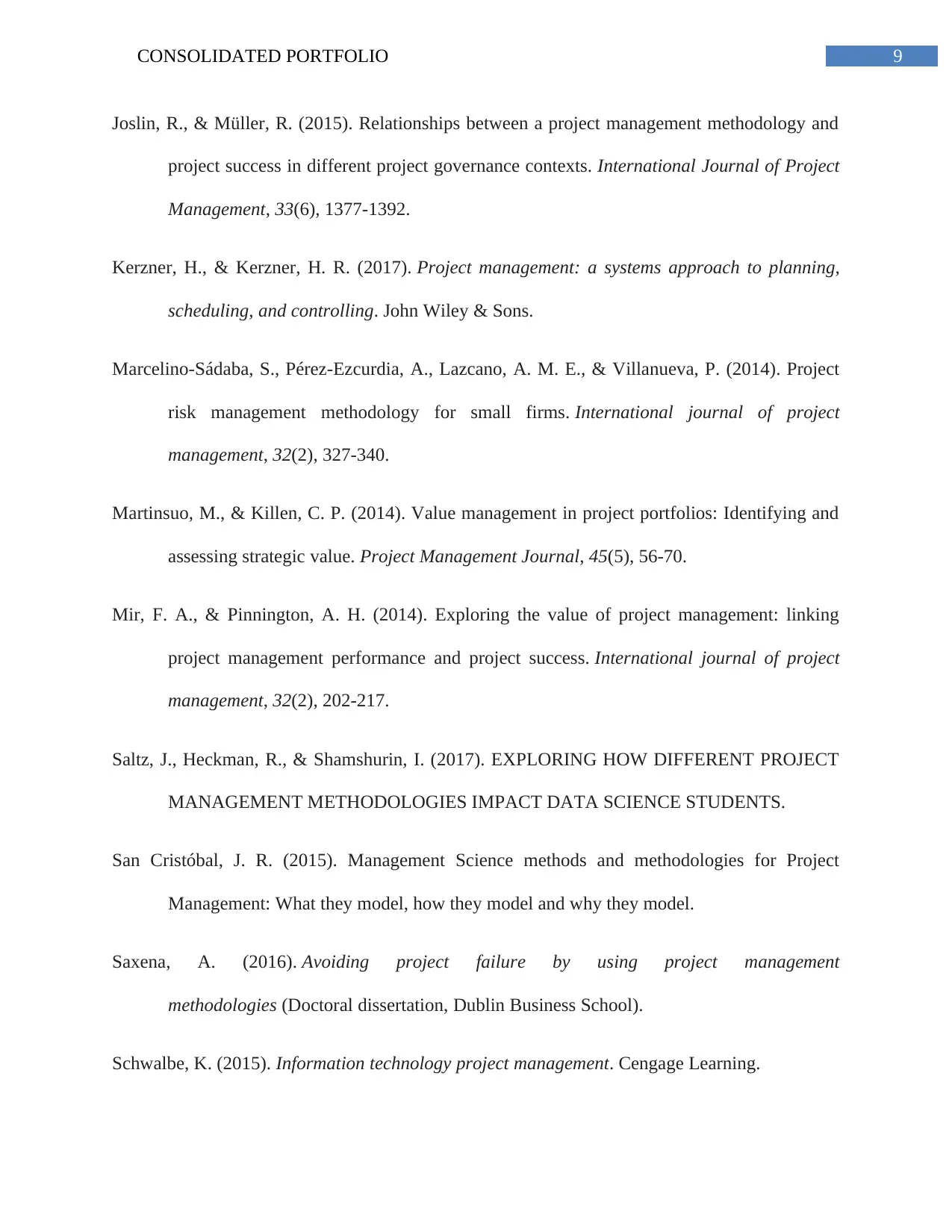
9CONSOLIDATED PORTFOLIO
Joslin, R., & Müller, R. (2015). Relationships between a project management methodology and
project success in different project governance contexts. International Journal of Project
Management, 33(6), 1377-1392.
Kerzner, H., & Kerzner, H. R. (2017). Project management: a systems approach to planning,
scheduling, and controlling. John Wiley & Sons.
Marcelino-Sádaba, S., Pérez-Ezcurdia, A., Lazcano, A. M. E., & Villanueva, P. (2014). Project
risk management methodology for small firms. International journal of project
management, 32(2), 327-340.
Martinsuo, M., & Killen, C. P. (2014). Value management in project portfolios: Identifying and
assessing strategic value. Project Management Journal, 45(5), 56-70.
Mir, F. A., & Pinnington, A. H. (2014). Exploring the value of project management: linking
project management performance and project success. International journal of project
management, 32(2), 202-217.
Saltz, J., Heckman, R., & Shamshurin, I. (2017). EXPLORING HOW DIFFERENT PROJECT
MANAGEMENT METHODOLOGIES IMPACT DATA SCIENCE STUDENTS.
San Cristóbal, J. R. (2015). Management Science methods and methodologies for Project
Management: What they model, how they model and why they model.
Saxena, A. (2016). Avoiding project failure by using project management
methodologies (Doctoral dissertation, Dublin Business School).
Schwalbe, K. (2015). Information technology project management. Cengage Learning.
Joslin, R., & Müller, R. (2015). Relationships between a project management methodology and
project success in different project governance contexts. International Journal of Project
Management, 33(6), 1377-1392.
Kerzner, H., & Kerzner, H. R. (2017). Project management: a systems approach to planning,
scheduling, and controlling. John Wiley & Sons.
Marcelino-Sádaba, S., Pérez-Ezcurdia, A., Lazcano, A. M. E., & Villanueva, P. (2014). Project
risk management methodology for small firms. International journal of project
management, 32(2), 327-340.
Martinsuo, M., & Killen, C. P. (2014). Value management in project portfolios: Identifying and
assessing strategic value. Project Management Journal, 45(5), 56-70.
Mir, F. A., & Pinnington, A. H. (2014). Exploring the value of project management: linking
project management performance and project success. International journal of project
management, 32(2), 202-217.
Saltz, J., Heckman, R., & Shamshurin, I. (2017). EXPLORING HOW DIFFERENT PROJECT
MANAGEMENT METHODOLOGIES IMPACT DATA SCIENCE STUDENTS.
San Cristóbal, J. R. (2015). Management Science methods and methodologies for Project
Management: What they model, how they model and why they model.
Saxena, A. (2016). Avoiding project failure by using project management
methodologies (Doctoral dissertation, Dublin Business School).
Schwalbe, K. (2015). Information technology project management. Cengage Learning.
Paraphrase This Document
Need a fresh take? Get an instant paraphrase of this document with our AI Paraphraser
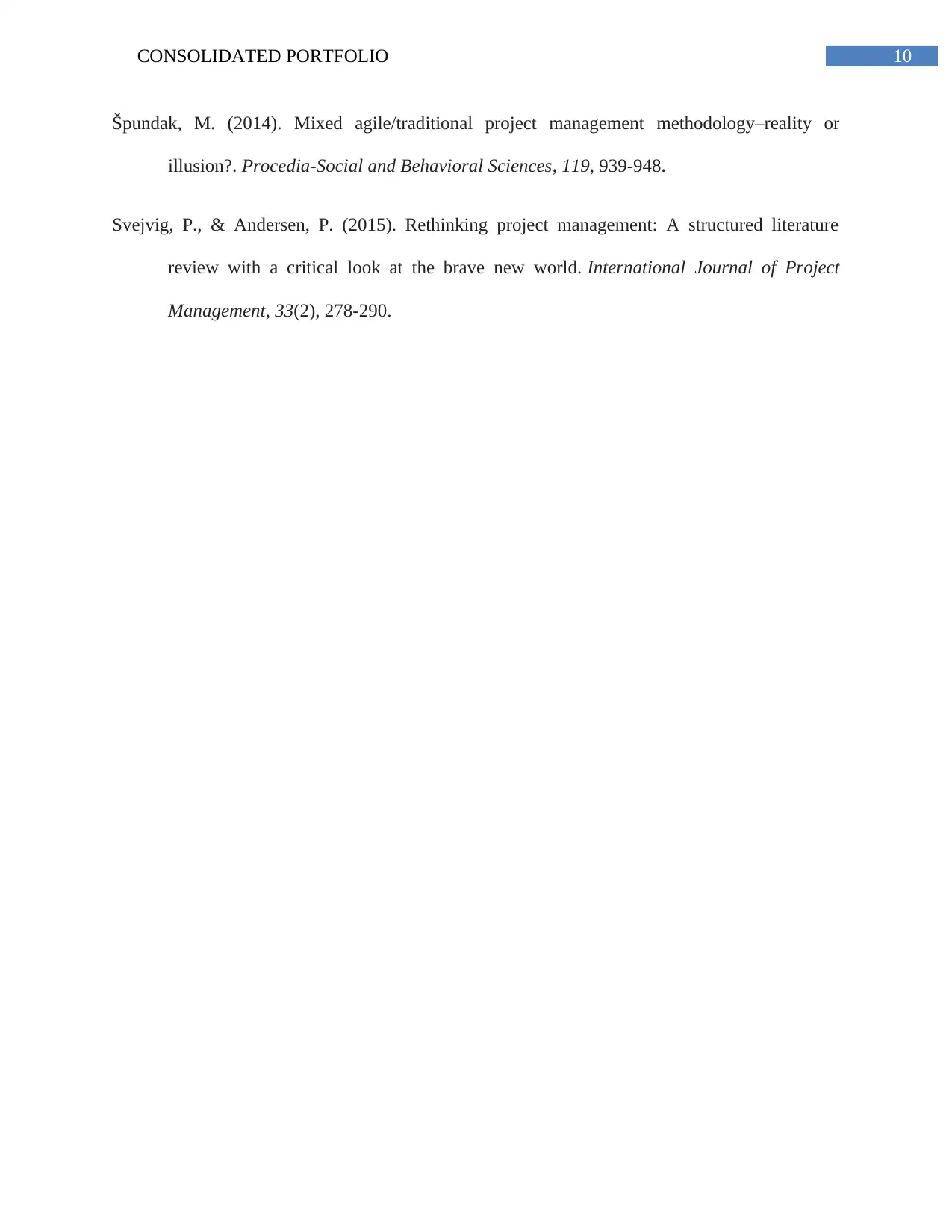
10CONSOLIDATED PORTFOLIO
Špundak, M. (2014). Mixed agile/traditional project management methodology–reality or
illusion?. Procedia-Social and Behavioral Sciences, 119, 939-948.
Svejvig, P., & Andersen, P. (2015). Rethinking project management: A structured literature
review with a critical look at the brave new world. International Journal of Project
Management, 33(2), 278-290.
Špundak, M. (2014). Mixed agile/traditional project management methodology–reality or
illusion?. Procedia-Social and Behavioral Sciences, 119, 939-948.
Svejvig, P., & Andersen, P. (2015). Rethinking project management: A structured literature
review with a critical look at the brave new world. International Journal of Project
Management, 33(2), 278-290.
1 out of 11
Related Documents
Your All-in-One AI-Powered Toolkit for Academic Success.
+13062052269
info@desklib.com
Available 24*7 on WhatsApp / Email
![[object Object]](/_next/static/media/star-bottom.7253800d.svg)
Unlock your academic potential
Copyright © 2020–2025 A2Z Services. All Rights Reserved. Developed and managed by ZUCOL.




